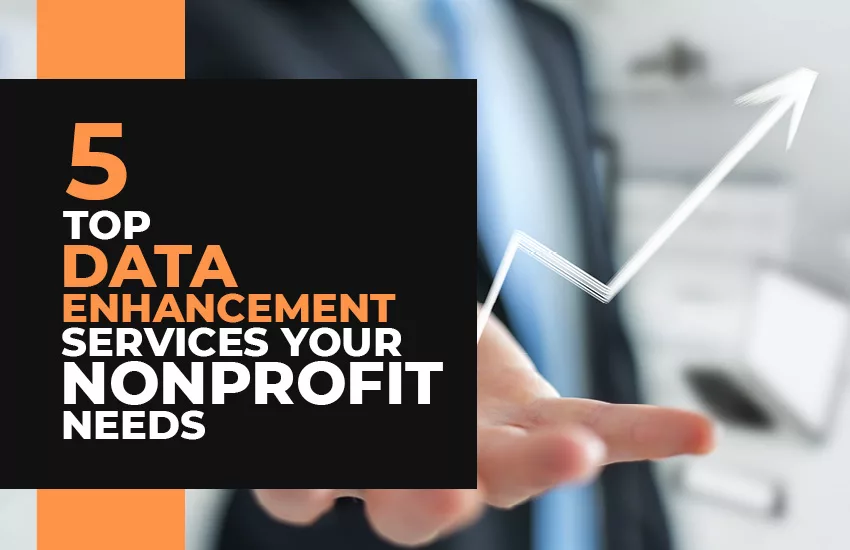
Gone are the days when data marketing was just for big corporations. Today, data enhancement is more accessible to more organizations than ever before, and nonprofits are jumping in.
In fact, nonprofits can significantly benefit from investing in robust and accurate constituent data. You’re likely already collecting data directly from your donors, volunteers, or clients when they fill out online forms, visit your website, or register for services. Collecting this core information, however, only scratches the surface—and limits what you can do with your data.
In this guide, we’ll take a look at five ways to enhance your in-house data that can help your nonprofit save money, increase fundraising, and communicate better:
- Consumer Data Append
- Firmographic Append
- Phone and Email Append
- Reverse Append
- Geo-Coding
Before we dive in, let’s first define data enhancement in a nonprofit context and the two general kinds of data enhancement services.
What Is Data Enhancement?
According to AccuData, data enhancement, also known as data append and data enrichment, is “the process of improving your, or your client’s, first-party data with context pulled from additional, external sources.”
Data enhancement processes can fall into two main buckets: batch appends and real-time appends.
With real-time appends, a third-party provider enhances your donor data in real-time as you collect it. For example, if a donor submits their name and address on your website, real-time append can add their additional contact information and demographic data to your database automatically.
With batch appends, a third-party provider enhances the existing data in your database all at once. For example, a nonprofit that wants to focus on increasing donations from its wealthiest donors might batch append wealth and income data on its constituents to better identify the top prospects.
5 Types of Data Enhancements for Nonprofits
Within the field of data enhancement, there are a range of services that each address unique nonprofit needs. Let’s look at the types of enhancement services that you might want to use and how each can benefit your organization.
Demographic Data Append
Best for organizations who want to: Understand their constituents, raise more money, and communicate more effectively and efficiently.
Demographic data appends are the largest category of data enhancement services and can offer tremendous insight into your supporters’ giving profiles. With this service, you can add detailed demographic information to your existing data, including:
- Age
- Income
- Marital status
- Hobbies
- Buying behavior
- Education
- Donation history
With these additional data points, you can quickly find the exact audience for your services or fundraisers and personalize outreach with relevant, impactful communications. Once you’ve appended this demographic information, you can segment your audiences according to pertinent characteristics. For example, if you’re interested in targeting major gift donors, you could append income and age data and filter based on these wealth indicators.
Firmographic Append
Best for organizations who want to: Solicit corporate sponsorships and grants.
When corporations offer nonprofit grants and sponsorships, they want to know that their money supports their community and business interests. If your nonprofit is soliciting corporate sponsorships for an event or capital campaign, it’s helpful to learn as much as possible about a business to tailor your request to directly address both elements.
A firmographic append allows you to add attributes to the businesses in your database, including:
- Industry
- Internal structure
- Annual revenue
- Market segment
- Location
- Web address
More importantly, this enhancement can also append job titles, phone numbers, email addresses, and the names of key contacts. Thus, you can easily reach decision-makers and make a case tailored to their needs and interests.
Phone and Email Append
Best for organizations who want to: Power multichannel marketing efforts with new, optimized contact information.
Say you’re trying to get in touch with a potential donor. But you wrote down an incorrect phone number, and they’ve since changed their email. How do you reach them if you have out-of-date information, and how do you update that information if you can’t reach them?
Phone and email append were designed to solve this exact problem. With this pair of data enhancements, you can add your supporters’ most up-to-date contact information. Here’s how each one works:
- Email Append identifies recent, active email addresses for the contacts in your database and confirms their desire to receive email communications. According to NPOInfo’s guide to email appends, direct email marketing can be an incredibly powerful tool when addressed to targeted audiences, returning an average of $36 for every $1 spent.
- Phone Append uses directory assistance data to add accurate, up-to-date telephone numbers to your donor data. As a result, you’ll be able to make your outreach more efficient, avoiding wasted time on misdials and deadlines.
Generally, it takes multiple touches across a number of communication channels for donors to commit to making a gift. By appending phone and email information, you can increase the variety of these interactions and deepen your supporter engagement.
Reverse Append
Best for organizations who want to: Know who they’re talking to.
In many cases, such as when signing up for an online newsletter or text updates, your supporters will input only a phone number or email address. While that’s a great sign of their engagement and interest in your cause, an email address or phone number alone won’t do you much good in the long term. That’s where reverse append comes in.
As its name suggests, a reverse append service uses only the phone numbers or email addresses in your constituent relationship management system to locate and add associated contact information, such as names and physical addresses. As a result, you can reach out to donors, volunteers, and constituents with automatically personalized messages, avoiding the generic and off-putting “Dear Supporter” salutation.
Geo-Coding
Best for organizations who want to: Reach the right audiences in the right locations.
A type of hyper-targeted marketing, geo-coding allows nonprofits to add latitude and longitude coordinates to supporter data. With this information, you can target and personalize your communications to geographically-specific audiences.
For example, if your nonprofit is trying to recruit volunteers to support a neighborhood event, geo-coding could help you serve Google Ads to potential volunteers who live or work in that specific neighborhood.
Next Steps: Choosing a Data Enhancement Service Provider
Once you know the type of enhancement services you need, you can choose a provider who can best help your nonprofit meet its goals.
While there are many data enhancement and marketing analytics companies out there, not all are made equal. Look for a provider that adheres to industry standards, uses tools that integrate directly with your existing tech stack, and offers comprehensive data marketing and analytics services that will make your data enhancement as impactful as possible. Good luck!
![16 Best Fundraising Platforms for Nonprofits [2024] 16 Best Fundraising Platforms for Nonprofits [2024]](https://www.dojiggy.com/files/sites/164/2022/07/best-fundraising-platforms-for-organizations-1-425x264.webp)


